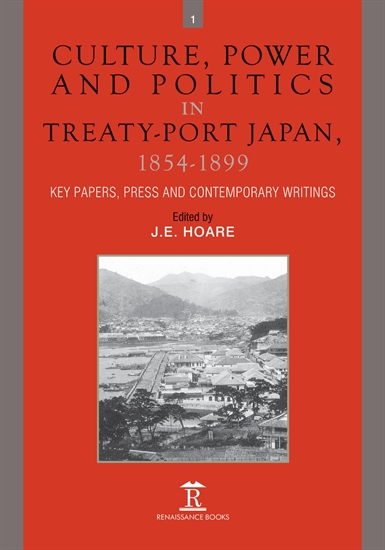A Friendly Disposition and Orderly Demeanour: Sources and Resources on the Japanese Treaty Ports
J. E. Hoare (ed.) 2018.
Culture, Power and Politics in Treaty-Port Japan, 1854-1899 (two volumes)
Folkestone: Renaissance Books
ISBN 9781898823612
Early on in Jim Hoare’s academic career, his PhD supervisor William Gerald Beasley suggested that he would not remain always ‘a treaty port man’. Beasley was both wrong and right: Hoare’s professional life in the UK’s Foreign & Commonwealth Office took him far beyond the subject of his doctoral research, but his fascination with the site of 19th century contact between Japan and the Western powers persisted alongside his day job. This two volume set represents a selection of sources collected by Hoare over 50 years of research, covering a broad array of material, both primary and secondary, on topics as varied as treaty texts and negotiations, economic history, the language of the ports, and whimsical poetry produced by their residents.
There are two groups for whom I think that this collection will prove of most interest. Firstly, I think that the combination of primary and secondary material will be a useful inspiration for undergraduate and perhaps also masters level students in search of a research topic. The diversity and range of different subjects engaged within the selection should provide students with a wealth of ideas to chase. So whilst this is not a cheap collection, it is one for which hopefully many university libraries will be able to find a home. The second audience for which I think the collection will be of interest is more established scholars, as a tool for understanding the scope of existing research on the treaty ports, and a prompt to inspire us to look at them anew.
I think that it is fair to say, without any slight on Hoare or other scholars featured in this collection, that the Japanese treaty ports have tended to be less central to the historiography of modern Japan (at least in the English language) than their importance in the second half of the 19th century might suggest. In the UK, the figures best known for their work on the subject have tended to occupy positions outside conventional university research posts (such as Hoare, that other great British scholar-diplomat, Hugh Cortazzi, or the writer Pat Barr, for example) and much of the higher profile work on them has tended to be more pedagogical in approach than usual research monographs (e.g. John Dower’s work at MIT Visualizing Cultures), or has focused on making available primary material (Fred Notehelfer’s Japan Through American Eyes, Routledge, 2001). This is, again, not to denigrate the value of the material that has been produced – quite the opposite: it is to argue that the discipline as a whole has tended to overlook research on a subject of considerable importance and interest. Indeed, these volumes suggest to me that, in the wake of global and transnational turns, the time is right to place the history of the treaty ports back into the heart of the field.

The extensive introduction lays out the history of Hoare’s research and the makings of the collection, as well as a brief history of the ports’ establishment and lifespan. I think it is notable, however, that relatively little space is devoted to consideration of the analytic significance of the material and the subject: for example, why are the treaty ports important, what are the pressing questions about them and their inhabitants, and what does this body of material as a whole tell us? Perhaps, after a lifetime working on the topic, the answers to these questions are so self-evident as to not require consideration, but I would suggest that they are the sort of things that we should be considering more explicitly as we continue to research the treaty ports of Japan.
This is an exercise already in progress: Douglas Howland, Simon Partner, and Steven Ivings, amongst others, have recently produced work on the ports, their inhabitants, and the ways in which they were administered. The treaty ports are a complex topic, and admit multiple perspectives, as revealed by the different approaches in this collection and these more recent researchers’ work. On the largest scale, one can think of them within the context of Japan, as Hoare’s collection does, or as parts of a broader Asia/Pacific network (an approach taken by Brunero & Puig’s recent Life In Treaty Port China And Japan, Palgrave MacMillan, 2018). There is also a more micro-level spatial dimension. Jeremy Taylor’s article on the Bund in Volume 1, as well as other pieces on the architecture of the treaty ports, and indeed the classic 1860s survey of Japan and China by Nicholas Dennys, all indicate that the construction and layout of the ports merits examination and interpretation. The ports were also home to a wide range of inhabitants: representatives of the Western Powers, of course, but also Japanese and other Asians (notably a large number of Chinese labourers, something highlighted by an essay in Volume One by Hoare himself, as well as more recent work by Eric Han). What is more, the Western residents comprised a mix, too: diplomats, traders, soldiers, sailors, missionaries, and, increasingly, ‘globetrotters’ passing through. In handling this mix, new models such as Mary-Louise Pratt’s idea of the ‘contact zone’ and the school of ‘new diplomatic history’ seem ideally placed to bring new insights to bear on the topic.
Reading this collection, then, is a reminder of the significance of the treaty ports, the value of the work already produced on them, and the potential for applying new insights and methods.
Ian Rapley, Cardiff University, United Kingdom